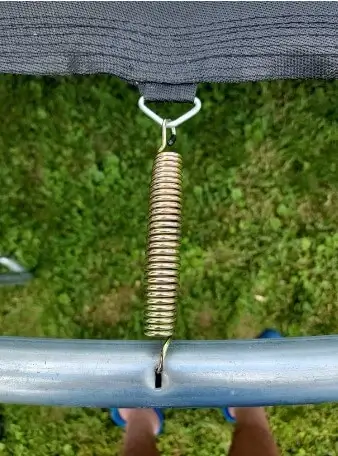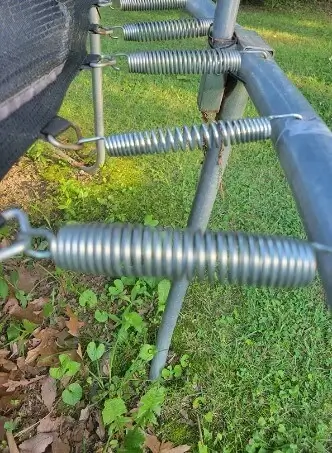How To Measure Trampoline Springs? 5 Excellent Ways
In order to get the most enjoyment and safety out of your trampoline, it is essential to make sure that all of the parts are functioning correctly. This includes the pad, frame, safety enclosure, and of course, the springs, which provide the “bounce” in your jump.

Over time, however, trampoline springs can lose their tension and need to be replaced or adjusted. This can be a tricky process, as the springs are under a lot of tension and can be dangerous to work with if not appropriately handled. So if you want to know how to measure trampoline springs or how to adjust or replace them, read on for some helpful tips.
Why Do You Want to Measure Trampoline Springs?
The springs on your trampoline are what provide the bounce, so it is important to make sure they are in good condition. If they lose their tension over time, they will not be able to provide as much bounce, which can lead to a dangerous situation. By measuring your springs and making sure they are still in good condition, you can keep your trampoline functioning properly and keep yourself safe while jumping.

How to Measure Trampoline Springs? [5 Different Ways]
There are a few different ways to measure trampoline springs, but the most common is to use a spring scale. This is a device that measures the tension or weight of an object by suspending it from one end.
Removing the Springs:
Before measuring the springs, you will first need to remove them from the trampoline. Follow the instructions below to do this safely.
- Unplug the trampoline and remove any screws or bolts holding the frame together. The springs will be attached to the frame with either hooks or loops.
- You can now carefully remove the springs from the frame with your hands. Be careful not to let them snap back and injure you.
- If the springs are attached to the frame with hooks, you can remove them by using a pair of pliers to twist them off. If they are attached with loops, you can cut them off with wire cutters.
- Remember to wear gloves and safety goggles when working with the springs, as they can be sharp and dangerous.
- Once the springs are removed, you can now place them safely.
The Spring Condition:
After you have removed the springs, you will need to inspect them to see if they are in good condition. Look for any cracks, bends, or kinks in the metal. If you find any damage, the spring should be replaced.
The Spring Length:
Once you have determined that the springs are in good condition, you can measure their length. Place one end of the spring on a flat surface and measure from there to the point where the spring curves. This is the length of the spring.
You can also Checkout! ARE LONGER TRAMPOLINE SPRINGS BETTER?
The Spring Diameter:
The next step is to measure the diameter of the spring. This is the thickness of the metal wire making up the spring. You can use a ruler or a tape measure for this. To do this, place the spring on a flat surface and measure the width of the spring at its widest point. This is the diameter of the spring.
The Spring Tension:
The next step is to measure the tension of the spring. To do this, you will need a spring scale. Suspend one end of the spring from the scale and attach the other end to a weight. The scale will give you a reading of how much tension is in the spring.
The tension of the spring determines how much bounce you will get when jumping on the trampoline. A spring with more tension will provide more bounce than a spring with less tension. Normally, the springs on a trampoline will be replaced or adjusted if the tension falls below 80% of the original tension.
Once you have completed all of these steps, you will have a good idea of the condition of your trampoline springs and whether they need to be replaced or adjusted. If you find that they are in poor condition, replace them as soon as possible to keep yourself safe while jumping.
Adjusting the Spring Tension
If you find that the tension in your springs is low, you can adjust it by adding or removing weight from the spring. To do this, you will need a spring scale and a weight.
- Suspend one end of the spring from the scale and attach the other end to the weight.
- Adjust the weight until the tension on the spring reaches the desired level.
- You can now remove the spring from the scale and reattach it to the trampoline.
- Remember to check the tension of the springs regularly to ensure they are in good condition.
Replacing the Springs:
If you find that the springs on your trampoline are in poor condition, you should replace them as soon as possible. To do this, you will need a new set of springs and a spring installation tool.
- Remove the old springs from the trampoline frame using a plier or a spring installation tool. Do it by gripping the spring at each end and pulling it out of the frame.
- Insert the new springs into the frame with the help of a spring installation tool like pliers. Make sure that the coils of the spring are facing downwards. Attach the other end of the spring to the trampoline frame. You can do this by looping it around a metal rod or attaching it with a clip.
- Test the tension of the springs by bouncing on the trampoline. If they are too tight or too loose, adjust them accordingly.
Frequently Asked Questions About How To Measure Trampoline Springs
Conclusion Of How To Measure Trampoline Springs
Trampoline springs are an essential part of the trampoline and play a vital role in providing a bouncy surface. They are also one of the most vulnerable parts of the trampoline and need to be regularly checked for tension and replaced if necessary. Adjusting the spring tension is a simple process that can be done with a spring scale and weight.
Replacing the springs is a more complex task that requires a spring installation tool. However, it is important to do this if the springs are in poor condition to ensure the safety of the trampoline.
